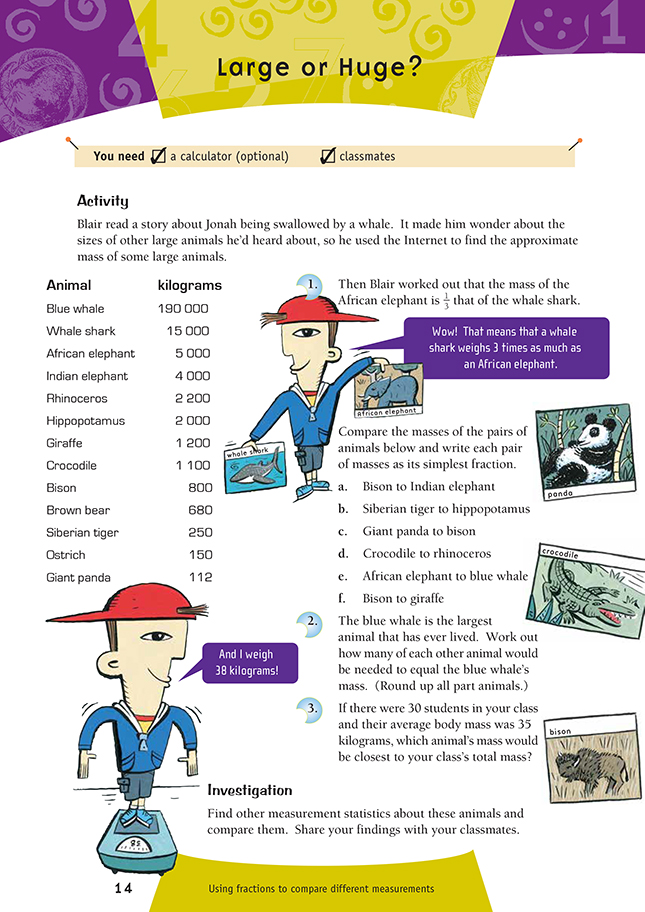This is a level 4 number activity from the Figure It Out series. It relates to Stage 7 of the Number Framework.
A PDF of the student activity is included.
Click on the image to enlarge it. Click again to close. Download PDF (243 KB)
simplify fractions
FIO, Level 3-4, Number, Book 2, Large or Huge? page 14
A calculator (optional)
Classmates
This activity builds on the previous page in that the students are expressing comparisons as simplified fractions. However, this time they are dealing with larger numbers, so they also need to draw on their knowledge of place value to simplify the fractions. The focus on mass and ratios links to the measurement strand of the curriculum. This activity is suitable for students who are advanced multiplicative or beyond. Students who use additive strategies may be successful, but the process
will be time-consuming and inefficient.
In question 1, the masses of pairs of different animals are compared and written as simplified fractions. The students can simplify the fractions using a variety of strategies that combine their knowledge of place value and common factors. For example, for the bison to Indian elephant (800 kg to 4 000 kg) the fraction is 800/4 000. Dividing the denominator and numerator by 100 leaves 8/40. Dividing the denominator and numerator by the highest common factor (8) leaves 1/5.
In question 2, the masses of the other animals are compared to that of the blue whale. The easiest way to calculate how many of each animal equals the blue whale’s mass is to use a calculator, but it is good practice for the students to estimate their answers first. The basic equation is: blue whale’s mass ÷ mass of other animal = number of other animals. For example, an estimate for 190 000 ÷ 5 000 could be based on 200 ÷ 5 = 40. (Another strategy for this is to see ÷ 5 as x 2 ÷ 10. So the estimate could be based on 190 x 2 ÷ 10 = 38.) The exact calculation is 190 000 ÷ 5 000 = 38 African elephants. Note that standard rounding procedures are not used for this problem. All part animals need to be counted as 1 whole animal. For example,
3.2 elephants ≈ 4 elephants, and 3.8 elephants ≈ 4 elephants.
The equation for question 3 is: number of students x average mass per student = mass of class. For 30 students, this is 30 x 35 = 1 050 kg, so the closest mass is the crocodile at 1 100 kg.
Investigation
See the comments on investigations in the notes for page 11.
Another statistic the students might like to compare is speed (the fastest land animal to other animals). There is also a wealth of human statistics available from the Guinness Book of Records and Olympic and Commonwealth Games records.
Answers to Activity
1. a. 1/5
b. 1/8
c. 7/50
d. 1/2
e. 1/38
f. 2/3
2. (All part animals have been rounded up to a whole animal.)
13 whale sharks
38 African elephants
48 Indian elephants
87 rhinoceros
95 hippopotamuses
159 giraffes
173 crocodiles
238 bison
280 brown bears
760 Siberian tigers
1 267 ostriches
1 697 giant pandas
3. The crocodile’s mass
Investigation
Results will vary
